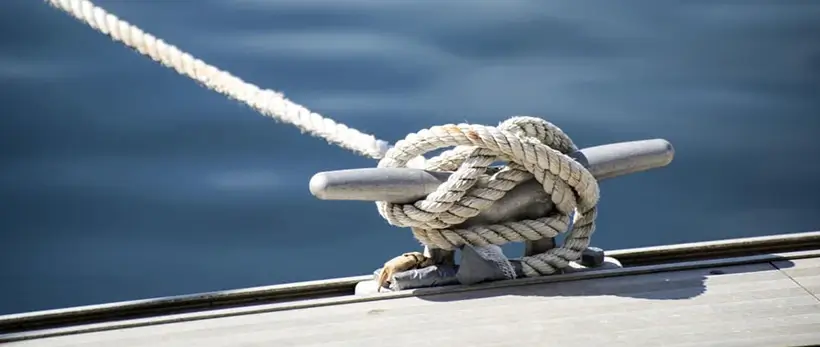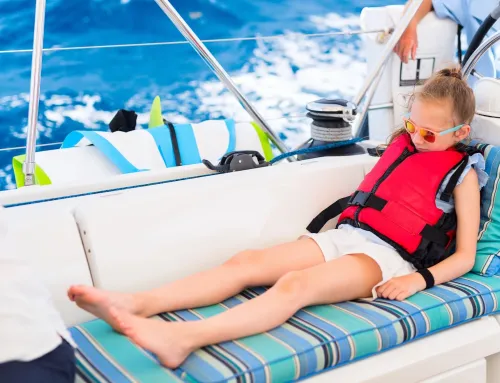
Sailing Skills: 7 Essential Knots to Learn
KNOTS & ROPES
Knots & and ropes: not only is it a source of pride for the majority of sailors who rent a yacht, but it is also an essential component of any maritime safety program. There are hundreds of different types of knots and ropes, but you don’t have to know them all, instead we are going to teach you the most important knots, so after you can with full confidence go on the boat and show your skills. There is no need to even use a boat! To practice tying these fundamental knots, all you need is some thread (rope or twine can also work!) and some spare time on your hands. So, let’s begin and make you seaworthy companion.
The Bowline Knot
This knot is one of the most popular knots because of its versatility and its widespread use, and not just among sailors and boaters. The most common application for it is creating a closed loop at the terminus of a line. It is highly secure, does not slip, and as a result, it will not cause the rope on which it is tied to get weaker. Even when knotted very firmly and after a significant amount of stress, it is quite simple to undo. You need to knot it really securely so that it can do its function correctly.
When tying to the ring, to cleats, and other locations, the spike is a very helpful tool to have. Even if there are more elegant and secure ways to join the ropes, it is possible to utilize two knots to accomplish the task. In addition, the barb can be knotted on a double rope to provide a secure knot consisting of two loops, each of which can be set independently of the other. It is in your best interest to practice tying the bowline knot quickly and precisely; being able to do so might save your life at sea.
Ridge or Reef Knot (Square Knot)
You might remember learning how to tie a square knot at summer camp when you were a kid. It is referred to as a reef on a boat because it is used for reefing and furling sails, as well as for connecting ropes to the reef and wrapping them around the reef. It is accomplished by first tying an overhand knot with the left hand and then switching to the right hand, or vice versa.
This produces a sitting knot on the furled sail that is nice and straight and well tidied up. You may even use it to wrap a scarf around your neck without having to worry about the knot being too tight and causing discomfort. However, there are far more appropriate and secure knots that may be used for that purpose, therefore connecting the ropes together is not something that is suggested. The sole practical application of a reef knot on a boat is to secure a reef. If the mainsail of the boat is furled up against the mast, you will most likely not need to use this knot at all.
Clove Hitch
This knot was first employed for the purpose of securing boats to piers in harbors. Although it is a relatively basic knot, there are several limitations to using it. It is made up of two straightforward folding knots that are placed in opposing directions of winding. However, when the object that is hooked to the cylindrical object can be turned, it is not suggested to use a trefoil hook since the object will almost likely become detached from the hook.
This knot is not recommended for use with ropes composed of synthetic fibers or in situations in which the weight on the knot is allowed to lighten or its intensity is drastically altered. As a result, alternative knots are used for mooring boats these days, with a loop that is either fastened or free on the posts; the tension of the rope is controlled by a mooring that is attached to the ship.
When connecting rope to a ring, a cloverleaf clip can be a very helpful tool. When it has not yet been loaded, the knot may be simply modified, which makes it possible to vary the length of the rope in a straightforward manner. Even in this instance, it is advisable to tie at least one more basic knot at the free end of the rope in order to secure it. Even after it has been secured quite securely, the clove hook may be released with relatively little effort, which is one of its many beneficial features.
Figure 8 Knot
This is a plug knot that is versatile in terms of the uses it can be put to and is pretty easy on the rope. It is common practice to apply it at the end of lines on ships to prevent the lines from slipping through the hand or from being untied. Sailors most frequently choose the figure eight as their plug knot of choice. It loosens far more readily than other knots, even after being subjected to a hefty load.
In order to safely link two ropes, a figure-of-eight bend, also known as a Flemish bend, is typically utilized. At the very end of one rope, a sloppy figure-of-eight knot is tied, and then the second rope is drawn back in a direction that is parallel to the first rope.
A figure eight loop may also be created by using a figure eight knot in its construction. This is precisely the same as tying a knot, except that it is done at the end of a rope that has been doubled. Climbers have shown a strong preference for the figure eight knot, which can be attributed to the several advantages it offers.
The Cleat hitch
The act of winding the line around the cleat and back around itself does not constitute a true knot. However, this does not lessen the significance of it when it comes to navigation. When it comes to sailing, this is one of the most helpful things you’ll be able to accomplish with a rope. A number of figure-eight rotations are performed on the cleat in order to ensure the rope is held in place securely. It is important to take precautions to ensure that the rope coming out of the boat forms an angle that is as acute as possible with the longitudinal axis of the cleat. This will ensure that the cleat engages in the longitudinal direction the greatest amount possible, while engaging in the transverse direction the least amount possible.
Even though it just takes a second to learn how to knot a cleat hook, if you can do it with pinpoint accuracy, you’re sure to garner some acclaim in the maritime community. In a nutshell, you should get proficient in tying this knot in all directions (left, right, upside down, and blindfolded), as you will use it very frequently. There is no question that having the yacht moored in a secure location is a positive thing.
Round turn
This is a simple knot that is utilized for tying and adjusting purposes. It is straightforward, yet it achieves a great deal. In most cases, it is utilized in the process of securing the rope’s terminus to a stationary object (eg an anchor). The method of tying the knot is accomplished by first forming a circular shape with the rope by wrapping it twice around the item, and then securing it with two standard knots. This knot is more likely to become tied than the speed, but once it is tied, it is more difficult to alter without first untying it. However, if necessary, it can be easily untied, and there is a very little chance that it will ever become trapped.
Anchor Hitch
It is possible to refer to either the Anchor Hitch or the Anchor Bend as the Fisherman’s Hitch or the Fisherman’s Bend. When used to tie an anchor line to an anchor, this knot works quite well. This knot, which can also be referred to as the fisherman’s bend or the anchor bend, is utilized to attach an anchor line to an anchor. A rope can also be attached to a ring or another termination using this method. When establishing a dual anchor in a hurry, it is helpful to have this. It does not significantly lessen the line’s strength, it is simple to tie, and it is little more robust than the Bowline. Even if you switch between putting a lot of weight on it and not much at all, the bend will not break.







